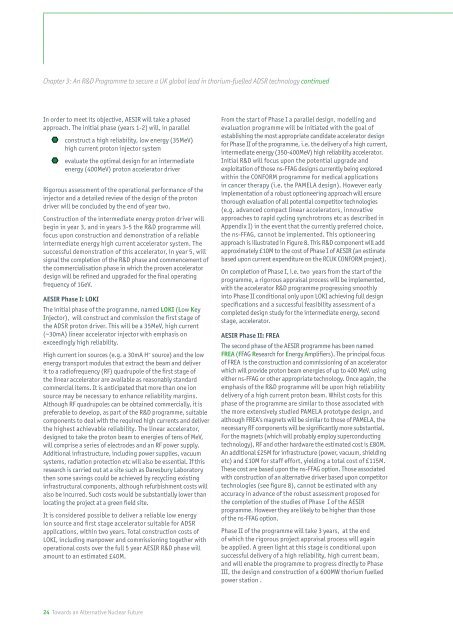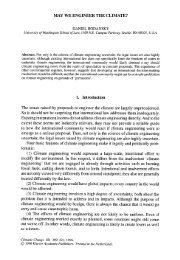ThorEA - Towards an Alternative Nuclear Future.pdf
ThorEA - Towards an Alternative Nuclear Future.pdf
ThorEA - Towards an Alternative Nuclear Future.pdf
You also want an ePaper? Increase the reach of your titles
YUMPU automatically turns print PDFs into web optimized ePapers that Google loves.
Chapter 3: An R&D Programme to secure a UK global lead in thorium-fuelled ADSR technology continued<br />
In order to meet its objective, AESIR will take a phased<br />
approach. The initial phase (years 1-2) will, in parallel<br />
construct a high reliability, low energy (35MeV)<br />
high current proton injector system<br />
evaluate the optimal design for <strong>an</strong> intermediate<br />
energy (400MeV) proton accelerator driver<br />
Rigorous assessment of the operational perform<strong>an</strong>ce of the<br />
injector <strong>an</strong>d a detailed review of the design of the proton<br />
driver will be concluded by the end of year two.<br />
Construction of the intermediate energy proton driver will<br />
begin in year 3, <strong>an</strong>d in years 3-5 the R&D programme will<br />
focus upon construction <strong>an</strong>d demonstration of a reliable<br />
intermediate energy high current accelerator system. The<br />
successful demonstration of this accelerator, in year 5, will<br />
signal the completion of the R&D phase <strong>an</strong>d commencement of<br />
the commercialisation phase in which the proven accelerator<br />
design will be refined <strong>an</strong>d upgraded for the final operating<br />
frequency of 1GeV.<br />
AESIR Phase I: LOKI<br />
The initial phase of the programme, named LOKI (Low Key<br />
Injector), will construct <strong>an</strong>d commission the first stage of<br />
the ADSR proton driver. This will be a 35MeV, high current<br />
(~30mA) linear accelerator injector with emphasis on<br />
exceedingly high reliability.<br />
High current ion sources (e.g. a 30mA H- source) <strong>an</strong>d the low<br />
energy tr<strong>an</strong>sport modules that extract the beam <strong>an</strong>d deliver<br />
it to a radiofrequency (RF) quadrupole of the first stage of<br />
the linear accelerator are available as reasonably st<strong>an</strong>dard<br />
commercial items. It is <strong>an</strong>ticipated that more th<strong>an</strong> one ion<br />
source may be necessary to enh<strong>an</strong>ce reliability margins.<br />
Although RF quadrupoles c<strong>an</strong> be obtained commercially, it is<br />
preferable to develop, as part of the R&D programme, suitable<br />
components to deal with the required high currents <strong>an</strong>d deliver<br />
the highest achievable reliability. The linear accelerator,<br />
designed to take the proton beam to energies of tens of MeV,<br />
will comprise a series of electrodes <strong>an</strong>d <strong>an</strong> RF power supply.<br />
Additional infrastructure, including power supplies, vacuum<br />
systems, radiation protection etc will also be essential. If this<br />
research is carried out at a site such as Daresbury Laboratory<br />
then some savings could be achieved by recycling existing<br />
infrastructural components, although refurbishment costs will<br />
also be incurred. Such costs would be subst<strong>an</strong>tially lower th<strong>an</strong><br />
locating the project at a green field site.<br />
It is considered possible to deliver a reliable low energy<br />
ion source <strong>an</strong>d first stage accelerator suitable for ADSR<br />
applications, within two years. Total construction costs of<br />
LOKI, including m<strong>an</strong>power <strong>an</strong>d commissioning together with<br />
operational costs over the full 5 year AESIR R&D phase will<br />
amount to <strong>an</strong> estimated £40M.<br />
24 <strong>Towards</strong> <strong>an</strong> <strong>Alternative</strong> <strong>Nuclear</strong> <strong>Future</strong><br />
From the start of Phase I a parallel design, modelling <strong>an</strong>d<br />
evaluation programme will be initiated with the goal of<br />
establishing the most appropriate c<strong>an</strong>didate accelerator design<br />
for Phase II of the programme, i.e. the delivery of a high current,<br />
intermediate energy (350-400MeV) high reliability accelerator.<br />
Initial R&D will focus upon the potential upgrade <strong>an</strong>d<br />
exploitation of those ns-FFAG designs currently being explored<br />
within the CONFORM programme for medical applications<br />
in c<strong>an</strong>cer therapy (i.e. the PAMELA design). However early<br />
implementation of a robust optioneering approach will ensure<br />
thorough evaluation of all potential competitor technologies<br />
(e.g. adv<strong>an</strong>ced compact linear accelerators, innovative<br />
approaches to rapid cycling synchrotrons etc as described in<br />
Appendix I) in the event that the currently preferred choice,<br />
the ns-FFAG, c<strong>an</strong>not be implemented. This optioneering<br />
approach is illustrated in Figure 8. This R&D component will add<br />
approximately £10M to the cost of Phase I of AESIR (<strong>an</strong> estimate<br />
based upon current expenditure on the RCUK CONFORM project).<br />
On completion of Phase I, i.e. two years from the start of the<br />
programme, a rigorous appraisal process will be implemented,<br />
with the accelerator R&D programme progressing smoothly<br />
into Phase II conditional only upon LOKI achieving full design<br />
specifications <strong>an</strong>d a successful feasibility assessment of a<br />
completed design study for the intermediate energy, second<br />
stage, accelerator.<br />
AESIR Phase II: FREA<br />
The second phase of the AESIR programme has been named<br />
FREA (FFAG Research for Energy Amplifiers). The principal focus<br />
of FREA is the construction <strong>an</strong>d commissioning of <strong>an</strong> accelerator<br />
which will provide proton beam energies of up to 400 MeV. using<br />
either ns-FFAG or other appropriate technology. Once again, the<br />
emphasis of the R&D programme will be upon high reliability<br />
delivery of a high current proton beam. Whilst costs for this<br />
phase of the programme are similar to those associated with<br />
the more extensively studied PAMELA prototype design, <strong>an</strong>d<br />
although FREA’s magnets will be similar to those of PAMELA, the<br />
necessary RF components will be signific<strong>an</strong>tly more subst<strong>an</strong>tial.<br />
For the magnets (which will probably employ superconducting<br />
technology), RF <strong>an</strong>d other hardware the estimated cost is £80M.<br />
An additional £25M for infrastructure (power, vacuum, shielding<br />
etc) <strong>an</strong>d £10M for staff effort, yielding a total cost of £115M.<br />
These cost are based upon the ns-FFAG option. Those associated<br />
with construction of <strong>an</strong> alternative driver based upon competitor<br />
technologies (see figure 8), c<strong>an</strong>not be estimated with <strong>an</strong>y<br />
accuracy in adv<strong>an</strong>ce of the robust assessment proposed for<br />
the completion of the studies of Phase I of the AESIR<br />
programme. However they are likely to be higher th<strong>an</strong> those<br />
of the ns-FFAG option.<br />
Phase II of the programme will take 3 years, at the end<br />
of which the rigorous project appraisal process will again<br />
be applied. A green light at this stage is conditional upon<br />
successful delivery of a high reliability, high current beam,<br />
<strong>an</strong>d will enable the programme to progress directly to Phase<br />
III, the design <strong>an</strong>d construction of a 600MW thorium fuelled<br />
power station .



